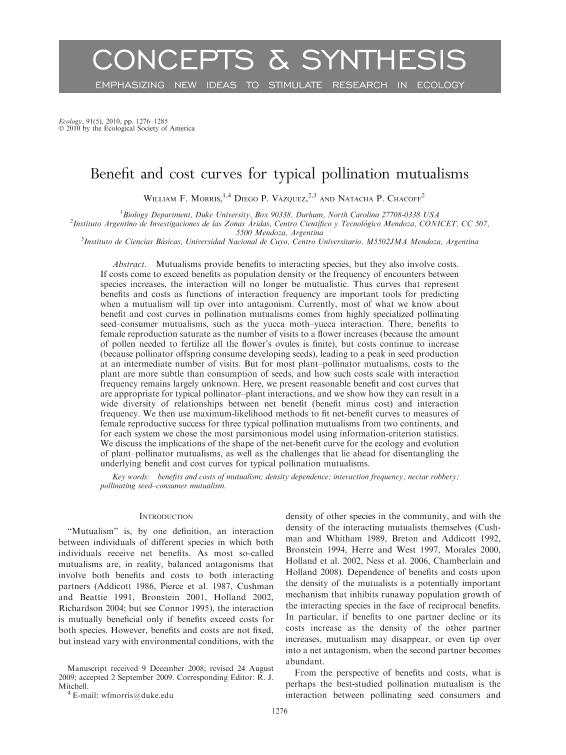Mostrar el registro sencillo del ítem
dc.contributor.author
Morris, William F.
dc.contributor.author
Vazquez, Diego P.

dc.contributor.author
Chacoff, Natacha Paola

dc.date.available
2019-04-15T20:14:44Z
dc.date.issued
2010-05
dc.identifier.citation
Morris, William F.; Vazquez, Diego P.; Chacoff, Natacha Paola; Benefit and cost curves for typical pollination mutualisms; Ecological Society of America; Ecology; 91; 5; 5-2010; 1276-1285
dc.identifier.issn
0012-9658
dc.identifier.uri
http://hdl.handle.net/11336/74423
dc.description.abstract
Mutualisms provide benefits to interacting species, but they also involve costs. If costs come to exceed benefits as population density or the frequency of encounters between species increases, the interaction will no longer be mutualistic. Thus curves that represent benefits and costs as functions of interaction frequency are important tools for predicting when a mutualism will tip over into antagonism. Currently, most of what we know about benefit and cost curves in pollination mutualisms comes from highly specialized pollinating seed-consumer mutualisms, such as the yucca moth-yucca interaction. There, benefits to female reproduction saturate as the number of visits to a flower increases (because the amount of pollen needed to fertilize all the flower's ovules is finite), but costs continue to increase (because pollinator offspring consume developing seeds), leading to a peak in seed production at an intermediate number of visits. But for most plant-pollinator mutualisms, costs to the plant are more subtle than consumption of seeds, and how such costs scale with interaction frequency remains largely unknown. Here, we present reasonable benefit and cost curves that are appropriate for typical pollinator-plant interactions, and we show how they can result in a wide diversity of relationships between net benefit (benefit minus cost) and interaction frequency. We then use maximum-likelihood methods to fit net-benefit curves to measures of female reproductive success for three typical pollination mutualisms from two continents, and for each system we chose the most parsimonious model using information-criterion statistics. We discuss the implications of the shape of the net-benefit curve for the ecology and evolution of plant-pollinator mutualisms, as well as the challenges that lie ahead for disentangling the underlying benefit and cost curves for typical pollination mutualisms.
dc.format
application/pdf
dc.language.iso
eng
dc.publisher
Ecological Society of America

dc.rights
info:eu-repo/semantics/openAccess
dc.rights.uri
https://creativecommons.org/licenses/by-nc-sa/2.5/ar/
dc.subject
Benefits And Costs of Mutualism
dc.subject
Density Dependence
dc.subject
Interaction Frequency
dc.subject
Nectar Robbery
dc.subject
Pollinating Seed-Consumer Mutualism
dc.subject.classification
Otras Ciencias Biológicas

dc.subject.classification
Ciencias Biológicas

dc.subject.classification
CIENCIAS NATURALES Y EXACTAS

dc.title
Benefit and cost curves for typical pollination mutualisms
dc.type
info:eu-repo/semantics/article
dc.type
info:ar-repo/semantics/artículo
dc.type
info:eu-repo/semantics/publishedVersion
dc.date.updated
2019-04-03T14:58:51Z
dc.journal.volume
91
dc.journal.number
5
dc.journal.pagination
1276-1285
dc.journal.pais
Estados Unidos

dc.journal.ciudad
Washington
dc.description.fil
Fil: Morris, William F.. University of Duke; Estados Unidos
dc.description.fil
Fil: Vazquez, Diego P.. Consejo Nacional de Investigaciones Científicas y Técnicas. Centro Científico Tecnológico Conicet - Mendoza. Instituto Argentino de Investigaciones de las Zonas Áridas. Provincia de Mendoza. Instituto Argentino de Investigaciones de las Zonas Áridas. Universidad Nacional de Cuyo. Instituto Argentino de Investigaciones de las Zonas Áridas; Argentina. Universidad Nacional de Cuyo. Facultad de Ciencias Exactas y Naturales; Argentina
dc.description.fil
Fil: Chacoff, Natacha Paola. Consejo Nacional de Investigaciones Científicas y Técnicas. Centro Científico Tecnológico Conicet - Mendoza. Instituto Argentino de Investigaciones de las Zonas Áridas. Provincia de Mendoza. Instituto Argentino de Investigaciones de las Zonas Áridas. Universidad Nacional de Cuyo. Instituto Argentino de Investigaciones de las Zonas Áridas; Argentina
dc.journal.title
Ecology

dc.relation.alternativeid
info:eu-repo/semantics/altIdentifier/url/https://esajournals.onlinelibrary.wiley.com/doi/full/10.1890/08-2278.1
dc.relation.alternativeid
info:eu-repo/semantics/altIdentifier/doi/http://dx.doi.org/10.1890/08-2278.1
Archivos asociados
